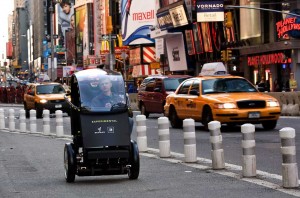
The GM/Segway PUMA uses a lithium-ion battery to power its electronic stabilization system and twin wheel motors. It will deliver 35 miles range at speeds up to 35 mph.
Horns blaring, tempers flaring, it seems like gridlock could soon overwhelm our cities. But an unusual project, pairing the mainstream automaker, General Motors, and the edgy, high-tech personal mobility manufacturer, Segway, could offer up an alternative that changes the way we drive in cities.
Dubbed Project PUMA – short for Personal Urban Mobility and Accessibility – it’s a battery-powered two-seater – but with only two wheels. If that brings to mind a bicycle or motorcycle, think again. Rather than a conventional, tandem layout, PUMA’s passengers ride side-by-side, thanks to the same stabilization system used in Segway’s one-person Personal Transporter.
A prototype of the GM/Segway concept will debut, this week, at the New York International Auto Show, at the Big Apple’s Jacob Javits Center. With the word, “Experimental,” emblazoned across the front, PUMA looks like a cross between a bubble car and a Chinese rickshaw, sans coolie pulling it through the streets.
“Project P.U.M.A. represents a unique solution to moving about and interacting in cities, where more than half of the world’s people live,” said Larry Burns, GM vice president of research and development, and strategic planning.
 Like the original Segway, PUMA relies on a unique stabilization system that eliminates the need for two additional wheels. It’s powered by electric motors – in this case, one in each wheel, and powered by an advanced lithium-ion battery pack – with electric steering and braking, as well. But the two-seater takes things several, er, steps further.
Like the original Segway, PUMA relies on a unique stabilization system that eliminates the need for two additional wheels. It’s powered by electric motors – in this case, one in each wheel, and powered by an advanced lithium-ion battery pack – with electric steering and braking, as well. But the two-seater takes things several, er, steps further.

Looking a bit look a rickshaw, minus the coolie, the GM/Segway could revolutionize urban motoring.
Individual PUMAs would be linked together in a city-wide network, so they can not only be tracked, but also to help each of the vehicles to “see” obstacles and steer clear of them. The network would automatically alert each PUMA where parking is available and even allow the two-seater to park automatically. Meanwhile, riders would be able to stay connected to the Internet while riding around town.
“Imagine moving about cities in a vehicle fashioned to your taste, that’s fun to drive and ride in, that safely takes you where you want to go, and “connects” you to friends and family,” said Burns, “without the stress of traffic jams.”
The two partners claim PUMA can achieve a 35 mph top speed, and run for 35 miles on a charge. Meanwhile, they claim the total cost of owning would run between one-quarter and one-third of a conventional automobile.
Whether there’s a future for PUMA remains to be seen. There’s a long history of pie-in-the-sky concept vehicles that do everything from swim to fly, but which never make it to market. There’s little doubt, however, that there’s a need for an alternative to the conventional automobile in urban settings. Small cars, such as the Smart fortwo have been gaining ground, especially in crowded Europe and Japan. PUMA would often an even more radical alternative.

This is a very clever concept. You could retain virtually every function stated in the article and make the vehicle much less complex by eliminating the the Segway balance system and simply putting a third, smaller, caster steered wheel in the front…like a shopping cart. The vehicle would still be driven and steered by the two rear wheels, but there would be no energy wasted by the balance which stabilizes the vehicle.
I realize the use of just two wheels makes it seem like magic. But, it is a waste of battery capacity when simply adding a third wheel would functionally achieve the same transportation goals.
But, Bob, don’t we all need a little magic in our lives?
I’m not sure how much power is actually used in a Segway for the balancing act. Considering the 35 mile range, I’m actually not sure you’d need all that much more. One of the questions I will ask, at the official news event, this morning, is how long it takes to charge. If you can fill ‘er up, so to speak, as quickly as a laptop computer or iPhone battery, the issue of running down the battery seems almost irrelevant. I’m assuming this vehicle would be used, as most, for several-mile runs within a city, not for commuting from a suburb into town. It just doesn’t seem solid enough for anything but very localized driving.
But let’s see when they let us ride in it.
Paul A. Eisenstein
Bureau Chief, TheDetroitBureau.com
Having ridden Segways, I think the balancing system would have greater usability over a third wheel. A Segway can negotiate a curb far better than a shopping cart can.
For what it’s worth, I brought your point up, Bob, with Segway’s product development chief, Philip LeMay, following their news conference with GM, on Tuesday.
Surprisingly, the 2-wheel approach is actually more energy efficient, according to Segway data. Yes, sitting idle and balancing burns up a few 100 watts, but according to LeMay, (and echoed by GM sources), PUMA uses virtually no additional power to stabilize once the vehicle gets moving. Actually, claimed LeMay, range is increased because you would have more rolling resistance with four wheels. And, you’d not have the turn-on-a-dime maneuverability.
For what it’s worth.
Paul A. Eisenstein
Bureau Chief, TheDetroitBureau.com
But what’s the towing capacity?
This is an interesting concept, but what about the present travelling infrastucture already being utilized by todays’ big cities? How long would it take to convert to such a new system?